
© Foteini Christofilopoulou. (Click image for larger version)
New Adventures
Matthew Bourne’s Cinderella
★★★✰✰
London, Sadler’s Wells
17 December 2017
Gallery of pictures by Foteini Christofilopoulou
new-adventures.net
www.sadlerswells.com
Matthew Bourne delights in deconstructing tradition and sewing it back together with sundry new twists. So, unsurprisingly, his Cinderella is not like any other Cinderella. It wasn’t exactly an Early Adventure but it was made twenty years’ ago, directly following the significant career-making success of Bourne’s reimagined Swan Lake.
The usual indistinct fantasy setting of some unspecified country and time has been starkly replaced by London in the Blitz. There is no magical transformation; no pumpkin that turns into a carriage; or furry animals that become coachmen; no fairy Godmother and no Prince, although these characters exist in other guises. The ball at the Palace has been exchanged for a night out at the Café de Paris (a real Soho nightspot) on the night that it was destroyed by a German bomb.

© Foteini Christofilopoulou. (Click image for larger version)
The evocation of London during the blitz is the production’s greatest strength. Lez Brotherston’s designs are not the 1997 originals, for which he won an Olivier Award, since these were lost prior to the 2010 revival; but, they are impressively authentic, creating a memorable journey through a London threatened by terror from the skies, accentuated with newsreel footage to provide a cinematic experience, complete with various subtle references to classic movies such as Brief Encounter and A Matter of Life and Death. This latter film provides a structural context to Bourne’s narrative: his “Prince” is a shell-shocked pilot, who has also escaped a close encounter with death, watched over by a guardian angel, and in the throes of a seemingly impossible romance.
Brotherston’s vintage costumes, ranging from snoods and peplums to the ubiquitous seamed stockings, are good enough to satisfy the most eagle-eyed WW2 re-enactor (so authentic that one supposes the CC41 Utility tag is stitched into each piece). Nothing seemed out-of-place apart from the conceit of a GI “Joe”, actually named Buster (Reece Causton), even though the setting is a year, or so, before the Americans arrived for combat! But, I guess that he augments the Hollywood allusion.
Buster is part of a cluttered household. There are two stepsisters, of course, with appropriately vintage (and film star) names, Irene (Stephanie Billers) and Vivien (Nicole Kabera) but they have no need to seek a Prince since Buster is already a boyfriend; alongside a very British “Tommy” in Sergeant Stan (a scene-stealing Danny Reubens, essaying a young Tommy Steele). There are also three stepbrothers, two of whom have girlfriends. In the corner of the room, confined to a wheelchair, by the fireside, is Cinderella’s hapless father (Alan Vincent). This very full household is dominated by the stepmother, a role reprised (from 2010) by Michela Meazza; captivating in her glorious, sexy, comedic impersonation of Joan Crawford – the original “Mommie Dearest”.
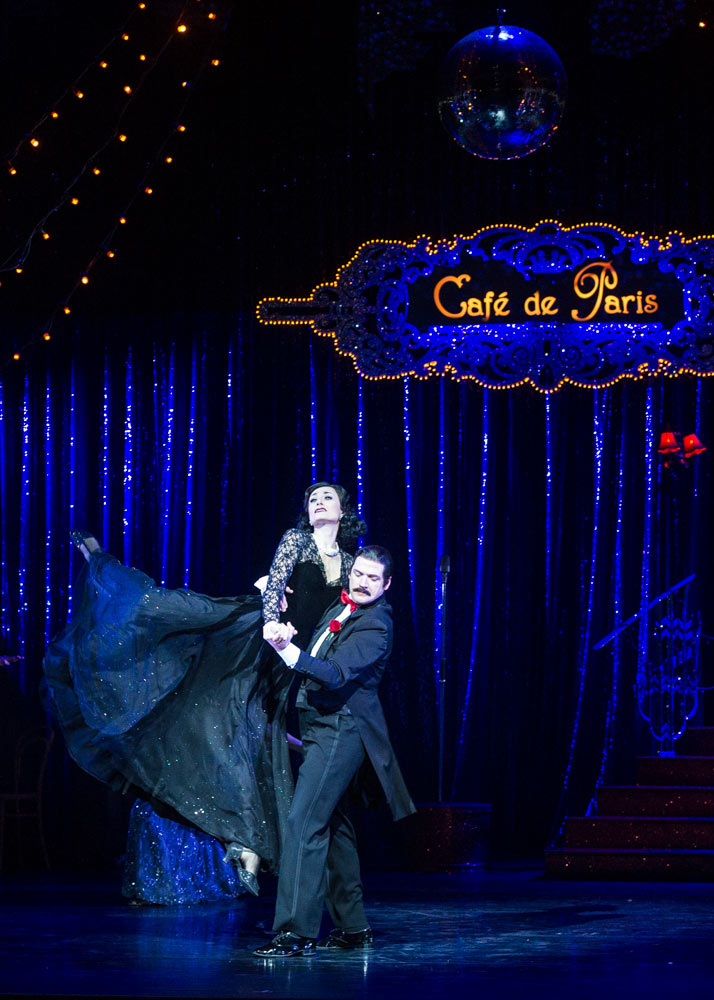
© Foteini Christofilopoulou. (Click image for larger version)
The role of Cinderella presents another considerable success for Ashley Shaw, recently nominated for a 2017 National Dance Award for her memorable portrayal of Vicky Page in The Red Shoes. She brings vivid expression and warmth to this wartime Cinders in her journey from traditional servitude to glamorous nightclub celebrity. Although it is unclear whether this is part of a Powell and Pressburger inspired dream, with ghostly apparitions of a band leader and dancers, killed in the Café de Paris explosion.
It is certainly most un-Cinderella-like for the heroine to spend a night in bed with her “Prince” (aka the afflicted airman, played with touching vulnerability by Andrew Monaghan). Neither does he roam the world looking for “the one” whose foot fits the slipper (here, a sparkling high-heeled dress shoe); instead, she finds him, recovering in a sanatorium. And, in another twist, typical of Bourne and again in tribute to classic movies (although here, more a case of It’s a Wonderful Life or The Bishop’s Wife) the Fairy Godmother has become a male Guardian Angel (Liam Mower) who enjoys a concluding Brief Encounter at Paddington Station as he spies – and approaches – his next ward.

© Foteini Christofilopoulou. (Click image for larger version)
Another cinematic device developed for this revisited production has been to envelope the action with Surround Sound utilising a 2010 recording of Prokofiev’s idyllic composition by the Cinderella UK Orchestra, conducted by Brett Morris, which is punctuated with aircraft noises, dogs barking and other wartime sounds. Bourne’s choice of a Second World War setting seems more logical when considered in the context of Prokofiev composing the score between 1940 and 1944. Those that left immediately after the ending missed a danced curtain call followed by a vibrant musical theatre number in a brief ensemble rendition of Glenn Miller’s Pennsylvania 6-5000.
While the production is supremely stylish and the characters well-observed with expressive and romantic choreography, the narrative is padded out in order to fill the music, particularly where traditional elements of Cinderella have been excised. The plethora of characters – with sundry stepbrothers, girlfriends and boyfriends – dulls some momentum and provides a cumbersome narrative, especially in parts of the crowded first Act.
This is nonetheless a very welcome return of a fascinating work that deconstructs the traditional fairy tale and places an essence of Cinderella into an alien context, which – above all else – pays reverence to the classic movies of the wartime era, beautifully captured in Brotherston’s alluringly authentic designs and Neil Austin’s effective lighting.












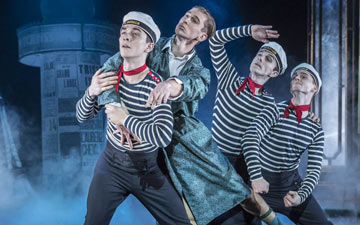
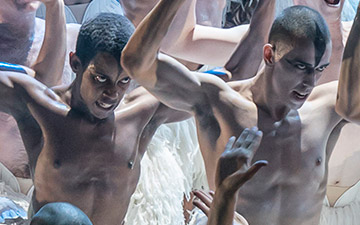
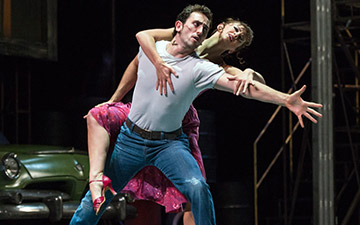

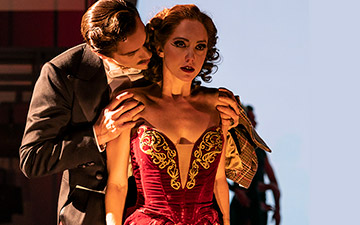
You must be logged in to post a comment.